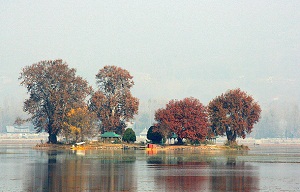An integral part of Kashmiri culture, the blossoming chinar’s beauty is celebrated by both artists and commoners alike. The tree appears endangered today, but Khursheed Wani believes in its immortality
KASHMIR: I grew up under the shade of majestic and gigantic chinar trees. I faced my first cricket ball in front of its stump. Learnt my first lesson under its cool breeze and understood my village’s unity in diversity under its canopy. Eighteen chinars, witness to every movement in my small beloved village of Deever, Tral, in south Kashmir, stand tall at every significant place. A Hindu temple, two mosque-shrine-enclaves, two gurdwaras and two schools all spread their collective wisdom through their branches.
I still miss the luxury of swinging on ropes tied to strong chinar branches on Baisakhi, marking the advent of the breezy and green spring.
‘Boune’, as Kashmiris call this exotic tree, is the hallmark of ‘Paradise on Earth’. It is intrinsic to the landscape of the region. There is hardly any village that lacks this royal possession, symbolising Kashmir’s pride and grandeur and exhibiting its dominant culture. Artists draw traces of chinar, its branches and palmate leaves on papier mache caskets while seamstresses replicate them on shawls and clothes with their magical needles and crafty hands. It has been the pillar of history, the muse of the poet, the haven of the divine. The fan leaves, which change their colour with the seasons from green in spring to yellow through summer and crimson in autumn have to be seen to be believed. The fall of leaves spreads a golden carpet around the chinar. This crisp carpet cushions the most strident footfall and takes one to a walk in the clouds.
‘Journey’
Boune – Platanus Orientalis, Linn, its rather long biological name, gives weight to botanists’ theory that it originated in Greece. King Asoka is believed to have imported and implanted it in Kashmir. According to legend, the boune has earned its name from the Hindu goddess Bhawani. Some say that during the Buddhist period, it was called Budhi which was later corrupted to boune. The present popular Persian name, chinar, owes its origin to Mughal emperor Jahangir. Story goes that on an autumn day, Jahangir set foot in Kashmir. From a distance, he saw a grove loaded with crimson eaves. In sheer ecstasy, he shouted, “Chi naar!” (What a blaze!), and his pliant courtiers picked up the expression to rechristen the grove.
Mughals patronised the chinar tree in Kashmir and spread it in every nook and cranny. Hundreds of trees were planted in the famous Mughal gardens, along the well-known roads and in the premises of grand mosques and shrines. When Akbar took over the reins of Kashmir in 1586, he ordered the planting of 750 chinar saplings on the shores of Dal Lake near Hazratbal. Naseem Bagh (garden of cool breeze) came up, and still exists with hundreds of colossal trees. It now houses a part of Kashmir University campus.
The Emperor was so concerned about the garden flourishing with chinars that he ordered the saplings be watered with milk. Poet of the east, Allama lqbal, travelled to Kashmir and wrote some of his best couplets under the shade of Naseem Bagh chinars. During emperor Aurangzeb’s reign, a blaze engulfed the Grand Mosque of Srinagar and razed it to cinders. Aurangzeb wrote to his governor on the tragedy and inquired about the fate of chinar trees grown in the lawns of the mosque. On knowing that the chinars were safe, he remarked, “The mosque can be rebuilt in a year or two, but it would have taken a long time to beautify it with chinars.”
The patronage of chinar trees continued during the Dogra rule (1846- 1947). The kings planted hundreds of them in Srinagar and the countryside. All structures reminiscent of Dogra rule palaces, gardens, colleges and hospitals are surrounded by chinar trees. Today, you can see the best pruned variety in the lawns of InterContinental, The Grand Palace, a heritage hotel that’s keeping the Dogra legacy alive.
The past is rooted to the tree, the trunk of an ageing chinar hollows out and legend goes that ghosts find shelter in them. Often mortals too have sought refuge as is borne out by Akbarnama and Tuzk-e-Jahangiri. When Akbar travelled to Kashmir, he was caught up in sudden rain, He, along with his 34 guards, took shelter in the large, hollow trunk of a chinar. Jahangir and his seven courtiers on horseback entered another chinar trunk to avoid thunder showers.
‘In Everything’
Sages meditated inside them and at many places, idols of Lord Shiva are placed in the epicormic branches grown around the trunk of chinars by Kashmiri Pandits. They adorn the chinars with flowers and smear vermillion on the bark as a mark of respect. At one place in Ganderbal, paying obeisance to a grand chinar is a must for the groom and bride before they formally enter into wedlock.
In Anantnag, a unique chinar has shot up with two major branches. One branch has evergreen leaves while the other follows the seasonal colour scheme. Locals believe the saints had touched the evergreen branch and it won’t wither. Ever. A visitor will hardly find a chinar without character. Each tree is named by association with an object. So there’s the Bregih boune (chinar of cranes because they provide shelter to hundreds of birds), Naid boune (a cluster where barbers set up shop), Maharaz boune (the bridegroom’s grove), Poshe boune (the guardian of the saffron fields), Astan boune (the grace of the shrine) and the Mandar boune (temple canopy).
It is one nature symbol that has lent itself to every conceivable imagination and interpretation. The 14th century mystic, Lal Ded, has in her wakhs (verses), likened a faithful wife to Shihij boune (a cool Chinar). When a young and strong person dies, people describe the loss as akin to the fall of a tree. And should you accomplish an impossible feat, people celebrate by forcing a log through the trunk of a chinar (boneh mohul tarun). Kashmiris wear their pride, choosing to name their cherished projects after the grand tree. Schools teach a Chinar series of books, the Hindustan Machine Tools’ watchmaking factory is called Chinar Watches Limited. And when the late Shaikh Abdullah, the tallest Kashmiri leader of recent times, chose to write his autobiography, he named it Aaatish-e-Chinar (fire of Chinar).
Muhammad Sultan Wadoo, an environmentalist, discovered the sub-continent’s biggest and oldest chinar at Chattergam in central Kashmir, 14.7 m high. But he is not ecstatic about his find, worried as he is about the rapidly depleting virgin wealth. In 1970, the Valley boasted 42,000 trees but now their number has dwindled to a mere 20,000. On its part, the Government has set up a Chinar Development Authority to make good the loss. Chinar remains deeply etched in Kashmiri culture.
Allama lqbal once predicted that Kashmir’s soil containing the fire of chinar would never be subjugated nor suppressed.“Jis khak ke zameer mein ho aatish-e-chinar, mumkin nahin ki sard ho woh khak-e-arjumand” (The land that has in its conscience the spark of chinars will never die down, this celestial land). Or as the poet lqbal said, the warmth of the Kashmiri soil can be attributed to “the blaze of chinars it nurses in its bosom.”
(The author is Senior Correspondent, The Pioneer)












